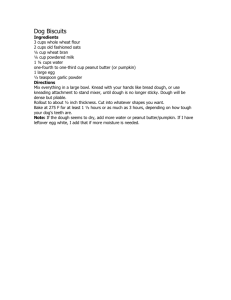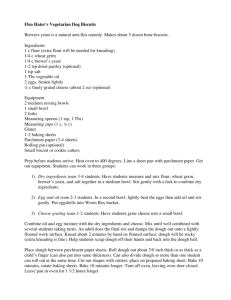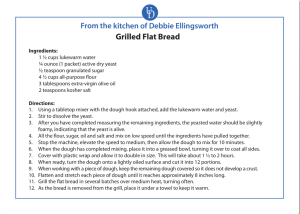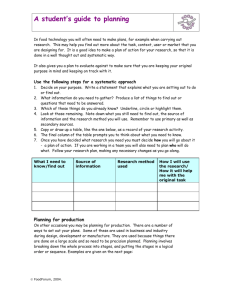Dutch Letters Works Cited
advertisement
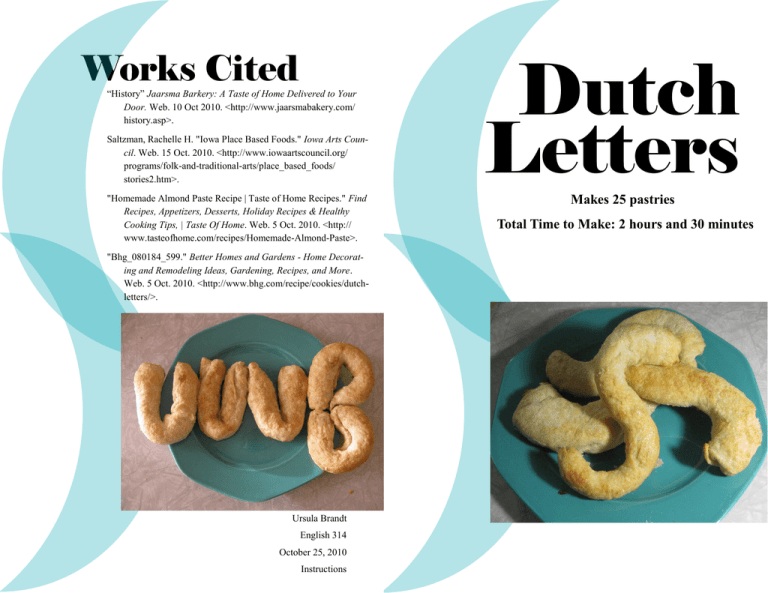
Works Cited “History” Jaarsma Barkery: A Taste of Home Delivered to Your Door. Web. 10 Oct 2010. <http://www.jaarsmabakery.com/ history.asp>. Saltzman, Rachelle H. "Iowa Place Based Foods." Iowa Arts Council. Web. 15 Oct. 2010. <http://www.iowaartscouncil.org/ programs/folk-and-traditional-arts/place_based_foods/ stories2.htm>. "Homemade Almond Paste Recipe | Taste of Home Recipes." Find Recipes, Appetizers, Desserts, Holiday Recipes & Healthy Cooking Tips, | Taste Of Home. Web. 5 Oct. 2010. <http:// www.tasteofhome.com/recipes/Homemade-Almond-Paste>. "Bhg_080184_599." Better Homes and Gardens - Home Decorating and Remodeling Ideas, Gardening, Recipes, and More. Web. 5 Oct. 2010. <http://www.bhg.com/recipe/cookies/dutchletters/>. Ursula Brandt English 314 October 25, 2010 Instructions Dutch Letters Makes 25 pastries Total Time to Make: 2 hours and 30 minutes History of the Dutch Letter Edible letters have a long history dating back to the Middle Ages and Germanic Tradition, During this time is was traditional to give babies the initial of the first name made from bread for good luck. Pastry letters have also appeared in stilllife paintings by the Dutch Masters dating back to the 16th and 17th centuries, like Still Life with Letter Pastries by Peter Binoit in 1615. 3. On parchment paper roll out remaining section into a 12 ½ by 10 inch rectangle. Using the ruler and pizza cuter cut the rectangle into five 10 by 2½ inch rectangles. 4. Take one tablespoon of filling and shape into 10 inch rope. Place rope in one slice of dough. Roll dough around filling and place on parchment covered cookie sheet with seem side down. Note: baking on parchment paper will prevent the pastries from sticking to baking sheet and keeps the bottoms of the pastries from turning black. The original Jaarsma bakery making Dutch Letters in 1920. Dutch Letters follow a pretty standard form of Northern European marzipan (Almond Paste) filled pastry, but this pastry has a unique tie to Iowa. In the late 19th Century, a group of Dutch immigrants came to Iowa and settled an area in Southeast Iowa now named Pella. The immigrants kept many of their Dutch traditions alive, one being that of making the Dutch Letter. 5. Use pastry brush to apply a thin layer of water on each pastry. Sprinkle granulated sugar over each wet pastry. 6. Bake for 10 minutes and then rotate the direction of the sheet and bake for another 10 minutes or until golden brown, as pictured on front. Remove from paper and let cool on cooling racks. History Letter Puttingof it the All Dutch Together Ingredients Tools Dough Oven preheated to 375° Almond paste Electric Mixer ½ cup granulated sugar Ruler ½ cup packed brown sugar Large sharp knife Pizza Cuter 1 egg white Baking sheets 1 cup water Parchment paper extra sugar to sprinkle on top of each pastry Pastry brush Cooling racks Traditionally and in the Netherlands today, the Dutch letter is made by local bakers for Sinterklaas Day (Santa Claus Day) on December 6th, but here in Iowa they are available year round due to their popularity. You can find the most authentic Dutch letters at the Jaarsma and Vander Plogg bakeries in Pella. Steps 1. In mixer add brown and granulated sugars with almond paste and egg white and mix until well combined. Set aside. Note: to remove yoke from egg, simply break egg over bowl, then hold egg so that break is horizontal, remove top and let whites drip down the sides of the shell while the yoke stays in bottom half of shell. Like shown in picture. 2. Using ruler and Large knife cut dough into 4 equal parts. Wrap three sections individually in plastic wrap and place in refrigerator. Jaarsma Bakery display If you can’t make it all the way to Pella, Iowa or the Netherlands, following these instructions to make your own deliciously authentic Dutch Letters. Almond Paste 7. Repeat the rolling and Ingredients Tools ½ pound whole almonds Food Processor Boiling water Bowl 1 ½ cups confectioners’ sugar Paper towels Wooden Spoon 1 egg 1 ½ teaspoons almond extract ¼ teaspoon salt folding process. (Steps 5 and 6) Then wrap dough in plastic wrap and place in refrigerator to chill for 20 minutes. 8. Unwrap dough and repeat Steps 5 and 6 twice more and wrap in plastic wrap and chill for another 20 minutes. Steps 1. Blanch Almonds 1) Place whole almonds in bowl 2) Pour boiling water to cover all of the almonds 3) Let stand for 1 minute 4) Drain, Rinse under cold water and drain again 5) Pat dry and use paper towels to slip off almond skins 2. Put blanched almonds in Food Processor and process until smooth. About 5 minutes. Note: Smooth means until the almonds are in finely processed and there are no lumps Note: Keep the parchment paper and the rolling pin well floured throughout the rolling and folding process to keep the dough from sticking. This process is essential to making the pastry light and fluffy. 5. Flatten ball and shape the dough into a rectangle. Make corners as square as possible. Use a floured rolling pin to roll dough into a 15 by 10 inch rectangle. Note: Use the rulers to keep on the right track. 6. Fold the 2 short sides to meet in center. Then fold in half to create 4 layers measuring 7 ½ by 5 inches. 3. When almonds are smooth, add sugar, egg, almond extract, and salt. Continue to process until thoroughly combined. Use wooden spoon to remove from processor. Note: You should use a wooden spoon to remove because it will not damage the blade of the processor and the blade will not damage the wood. Dough 3. In the small mixing Ingredients Tools 4½ cups all-purpose flour Large mixing bowl 1 teaspoon salt Small mixing bowl 1 beaten egg Wooden spoon 1 cup of ice water Parchment paper 2 cups cold butter (1 lb) Rolling pin Ruler Plastic wrap Steps 1. In a large mixing bowl, stir together flour and salt. In small mixing bowl cut cold butter into ½ inch thick slices—not cubes. Note: You can use the tablespoon marks on the outside of the butter wrapper as a ½ inch guide. 2. Add butter to flour mixture and toss until slices are coated and separated. bowl stir together the egg and ice water. Add all at once to flour mixture. Using a spoon, quickly mix—butter will remain in large pieces and the flour will not be completely moistened. Note: Picture is before mixing quickly together. 4. Turn the dough out on a piece of floured parchment paper. Knead* the dough 10 to 15 times by pressing and pushing dough together to form a ball. Butter should be well combined into dough. B A Note: the use of parchment paper is to create an easily cleanable surface that the dough won’t stick to. Use masking tape to secure paper to work surface. *How to knead dough: As well as you can, shape the dough into a ball. Then press heel of hand firmly in the center of dough, pushing forward slightly. Fold right half of dough on tap of the left half (A). Push down at center with heel again (B). Rotate 90° dough and repeat.
